As I mentioned earlier, linear perspective can have multiple vanishing points. There are three types of linear perspective that use vanishing points: 1-point, 2-point, and 3-point perspective.
1-Point Perspective
In 1-point perspective, every object appears to vanish towards one vanishing point, and every object either runs parallel or perpendicular to our eye level.
You can see the dramatic effect that changing eye level can have on objects in 1-point perspective:
You might experience 1-point perspective when looking down a very long hallway or waiting for a C train uptown:
 |
Empty platform in 1-point perspective |
2-Point Perspective
Ready for more points? The term 2-point perspective is used when objects are at an angle to the eye level other than parallel or perpendicular and there are two vanishing points.
In this case, each of the sides of the object facing you appear to be aimed towards different vanishing points located to the far sides of your eye level.
Notice the effect of eye level on objects in two-point perspective:
Depending upon how close you are to an object, you may not even be able to see the vanishing points, as they may lie beyond the range of your line of sight. This typically happens when objects are foreshortened.
 |
See how foreshortened this car looks in 2-point perspective? |
3-Point Perspective
Time to lay a third point on you. The term 3-point perspective is used when an object is particularly tall or stretches very far below our eye level.
This phenomenon occurs when the object stretches so far to the end of our line of sight, or even beyond it, that the top or bottom of the object appears to vanish.
A good example of this is when you look at a skyscraper. See how the top of this skyscraper appears to get smaller as it recedes into space?
Linear perspective is just one way that we are able to organize objects in space. Another concept that will help you visualize (and represent) structure is positive and negative space. Let's start our discussion of positive and negative space by first talking about mass and voids.
Mass and Voids
Mass is any solid object. In the loosest meaning it is anything that isn't nothing. Mass fills space. Where there isn't mass there's a void. A void is nothing.
Stick out your hand. Your hand has mass. Now notice the air around your hand. Before you stuck your hand out, there was a void filled with empty space. When you stuck your hand out, you partially filled that void with the mass of your hand. The space around your hand is still an empty void though. This relationship between mass and void is referred to as positive and negative space.
 |
My outstretched hand is a mass filling a void. |
Now that might be easy to understand when you're dealing with your real hand in real space, but how do you translate this information in your drawing?
Positive and Negative Space: Two Pieces of the Puzzle
There are several different ways to determine the positive and negative space in your drawing. Remember that every situation is relative and it is how the pieces relate to each other that create interest in your drawing.
Another way to think about positive and negative space is to think of them as pieces in a jigsaw puzzle. When you are putting together jigsaw pieces you don't think of any one piece as more important than another. What is important is how the pieces interconnect to make up the larger picture.
Positive and negative space is the same way. Let's look at the still life I set up with a few objects I had in my studio:
Each of the objects in the still life has mass and makes up the positive space. Below I have silhouetted the shape of the positive space in black.
You can see that it forms a very distinct shape in which separate objects are connected. When we draw the positive space of our objects we should focus on just the outer edge of the objects. Think of a cookie cutter. A cookie cutter is a great example of the shape of the positive space. It follows one continuous line around the edge of the objects, like an outline.
Let's not forget that the negative space has a shape, too. Here I silhouetted the negative space (the space around the mass) and filled it in black.
In this photo (as in any drawing), an artist must notice how the positive and negative spaces make shapes and how the shapes interconnect.
When you are busy focusing on the positive space in your drawing and the mass that fills it, make sure you also spend equal time focusing on the negative space and the shape around the void that the mass creates. Sometimes it might actually be easier for you to concentrate on the shape of the negative space when you're drawing something rather than focusing on the positive shape. Of course, once you have defined the shape of the negative space you have defined the shape of the positive shape as well; it's like two pieces in a puzzle.
Simply put, positive space is the space occupied by your subject. Negative space is the space around the object.
Positive and Negative Shapes
Now once you understand how to break up your drawing into the positive space of the object and the negative space around the object you can then further subdivide the space within an object into positive and negative by breaking your subject down into shapes.
That's right. You can actually have positive shapes and negative shapes within the positive space of any one object. Anytime you can identify a shape within your subject, that shape can instantly be considered the positive shape and the area around it a negative shape.
In the example of a chair below you can see how within the positive space of the chair we can actually further break down the chair into smaller internal positive and negative shapes.
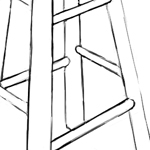
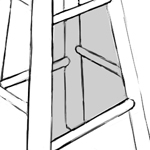
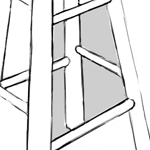
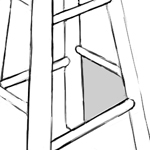
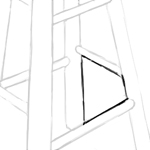
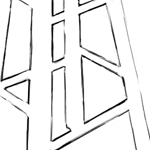
Remember that we are drawing on a flat piece of paper and at the end of the day we are ultimately drawing flat shapes. So learning how to see the positive and negative space and shapes in your subject will make it easier for you to translate that information onto your page.
Now let's try putting some of this theory to work!

